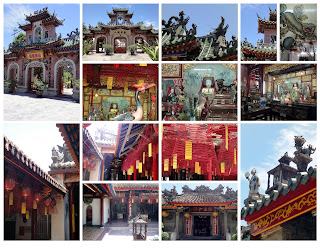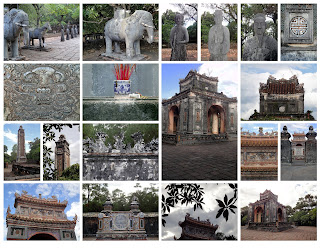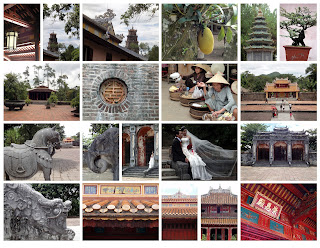On thursday, july 28th we arrived in Ho Chi Minh Ville, otherwise known as ex-Saigon. What vitality, what energy, a bubbling, always on the go city. In the midst of the hustle and bustle, timeless alleys with ancient pagodas,like this one, markets and shops selling silk, spices and baskets, and rain, rain, more rain, for we are visiting during the very rainy season!!! At each street corner there is a cheap poncho vendor, much appreciated! Impossible not to remember the haunting memories of Saigon, that made for nightmarish daily news with Walter Cronquite on television in the sixties and such film classics as "Good morning America" until the final fall in 1975. The past is the past, and the page has been turned thank goodness. Here is the Thien Hau Pagoda dedicated to the sea goddess, in the chinese Cholon district.
Jeudi 28 juillet 2011: arrivée à Ho Chi Minh Ville, ex Saigon; quartier chinois de Cholon, pagode de la Dame Céleste.
Cho Ben Thanh, otherwise known as the Ben Thanh market; city hall, the opera, the main post office, Notre Dame Cathedral, (not to be confused with the one in Paris!)... and other official buildings in the old french colonial district. Ho Chi Minh was named in honor of the leader who successfully led the nation against France and later the United States. It has retained some of its French colonial influences, especially in this this area. The streets are jam-packed with mopeds and scooters, making it near impossible for foreign pedestrians to cross the streets!!! Walking on the famous ex-rue Catinat, one of the main axes of colonial Saigon, with the Hôtel Continental, near the river, seams to bring you a hundred years or so, back in history.
Les Halles Binh Tay et les édifices de l'ancien quartier colonial avec l'ex-rue Catinat, l'Opéra, l'Hotel de ville...
On friday, july 29th, on our way to the Mekong Delta further south, we made a stop in a Caodaist temple. The Caodai religion is essentially a vietnamese religion, founded in the 1920's and is a funny mixed salad of Confucianism, Taoism, Buddhism, and Christianism. What may sound completely outrageous is that their spiritual leaders or saints include Buddha, Jesus Christ, but also Napoleon Bonaparte, Thomas Jefferson, Winston Churchill, Victor Hugo, Descartes, Joan of Arc, Louis Pasteur, Leon Tolstoi, Lenin, or Shakespeare!!!
Oh and look at that guy carrying a truckload of stuff on, around, in back of his bike, this sort of ordinary scene won't cease to amaze me during the whole entire trip!!!
Vendredi 29 juillet 2011: départ pour le delta du Mekong; halte dans un atelier de lacque et dans un temple caodaïste.
Mekong means nine dragon river in vietnamese. Life in the Delta revolves around this muddy brown river making villages mostly accessible by boat. A real labyrinth! We stopped in a village that made the most delicious coconut taffee! I bought one bag, but should have bought ten! The vegetation is quite lush; I don't know about the brown water though, yuck!!!! This is the area where they produce most of their rice! Is this how brown rice is made??? Hmmm....
Croisière au coeur d'un labyrinthe de rivières et de canaux jusqu'au port fluvial de Vinh Long
Arrival in the city of Can Tho for the night. It's raining, it's pouring; who cares, we still have our cheap plastic ponchos that are starting to rip apart, full of holes like swiss cheese!!
Arrivée pour la nuit et par la route à Cantho.
On saturday, july 30th, we took a boat ride again early in the morning to the floating market of Cai Rang. On the way, I couldn't help looking at all the houses along the river. Even if it isn't Palladio architecture, I found vietnamese architecture interesting, I don't really know why! Once we arrived at the market, for sure it had nothing to do with your local western supermarket!
Samedi 30 juillet 2011: ballade en bateau jusqu'au marché flottant de Cai Rang
The boat left us back in Can Tho where we took a walk around the market before taking the road back to Ho Chi Minh Ville. Stopping to look at at all the exotic fruits and vegetables is always truly a treat.
Marché à Cantho avant de reprendre la route pour Mytho et retour à Ho Chi Minh Ville.
Sunday, july 31st before our flight to Da Lat, we took one last walk around the market and a street nearby full of antique dealers. I have a hunch that they were new antiques like in China! Yes, there are 85 million people in Vienam, endlessly rolling hastely here and there; how do they expect us to cross the streets... they never ever stop! I don't believe I ever saw a "stop" sign during the whole trip!!!! Perhaps we could suggest them to put some, but I'm not sure it would change matters much! The Vietnamese although, very kind and polite, go by their own rules!
Dimanche 31 juillet 2011: quartier des antiquaires à Ho Chi Minh Ville.

Around mid-day we landed in Da Lat north west of Ho Chi Minh Ville, on the Langbiang Plateau at 1500m of altitude, not as hot and humid but nice and cool. Also known under the name "le petit Paris"!!!, it is the city of thousands of pine trees! Because of the climate, the French endowed the city with villas, which look like swiss chalets,during their colonial days. The train station is supposed to have been inspired by the one in Deauville, here in France. The architecture of Da Lat is dominated by the style of the French colonial period, so that even today, it almost feels like we were hiking somewhere in the Alpes!!! We started out by visiting the last emperor Bao Dai's kitschy summer residence, built in 1937. The gift shop was simply surreal..., no comment!
Arrivée par avion à Dalat, station d'altitude; visite de l'ancienne résidence d'été du dernier empereur Bao Dai, la gare, le quartier des colons français.
The following day, on monday august 1st, we took the road towards the high plateaux northbound, stopping in a coffee plantation and first villages of Eddé and Mnong tribes.
Lundi 1er août 2011: plantation de caféiers. Premiers villages des peuples Eddé et Mnong des hauts plateaux.
After lunch we took a nice pirogue ride on the lake Lak before going elephant back riding! Wow! Good thing asian elephants are smaller than africans!!! Imagine driving your very own elephant on the Champs-Elysées!!!!Yhen we arrived in Buon Me Thuot, the coffee capital of Vietnam.
Ballade en pirogue sur le lac Lak, et à dos d'éléphants avant d'arriver à Ban Me Thuot.
On tuesday august 2d, we left for Pleiku, home of the Jarai hill tribe, then for Kontum home of the Bahnar hill tribe. The central highlands is one of the most remote and least populated regions of the country, with its virgin forest, mountains, and wildlife, much of it having been destroyed during the fierce battles of the american-vietnam war in the 60's. Oh my gosh...; the area is rather poor, and all of a sudden, who do I see? Is it the vietnamese version of Ringo Star playing the drums in the middle of nowhere?
Mardi 2 août 2011: départ pour Pleiku et ensuite Kontum
Tiger balm is made from the Camphor tree. Also a stop in a pepper plantation, rubber trees that give latex, rice fields and tea plantations...
LeCamphriers (avec lequel on fait le baume du tigre), plantations de poivriers, hévéas (qui donne le latex), rizières et plantation de thé.
We arrived in Kontum, near the borders of Laos and Cambodia. In the Banhar dialect, "kon" means village and "tum" means pond, or lake. The town is surrounded by ponds and lakes. When it rains the roads look like rivers. During the french presence, missionaries were trained here to evangelize the minorities of the region.
Arrivée à Kontum.
On wednesday august 3d we visited Jaraï, Eddé and Banhar villages.
Mercredi 3 août 2011: Villages Jaraï, Eddé et Banhar.
Cemetary, where each family has its own lot in a Banhar village. The tombs are a replica of home, the table being set for lunch or dinner!.
Cimetière collectif par famille dans un village Banhar, dans lequel les tombes sont des répliques de l'habitat.
Wooden roman catholic church on stilts in Kontum and an orphanage. I kept a bagfull of ballpoint pens to give away, that I brought with me and thought this would be the perfect place to leave them. This was a very emotional place, as I had never set foot in an orphanage. To see these poor little ones, was truly heart breaking. I don't like taking photographs such as these, but then I don't want to ever forget this, so as to always remember how lucky we are.
Eglise en bois à Kontum et orphelinat catholique.
Here is a french built seminary in Kontum, which also hosts a small museum on local tribes, mostly the Banhar. The french missionary presence dates back to 1851. After that we went to a Jaraï village nearby.
Séminaire à Kontum et village Jaraï dans les environs.
A Jaraï village, and last evening in Kontum. As most everywhere in Asia, I'm always impressed by all these street vendors who come to sell their products on the sidewalks.
Village Jaraï et dernier soir à Kontum.



























































